German Travel Memories 1 - Michael in Frankfurt am Main
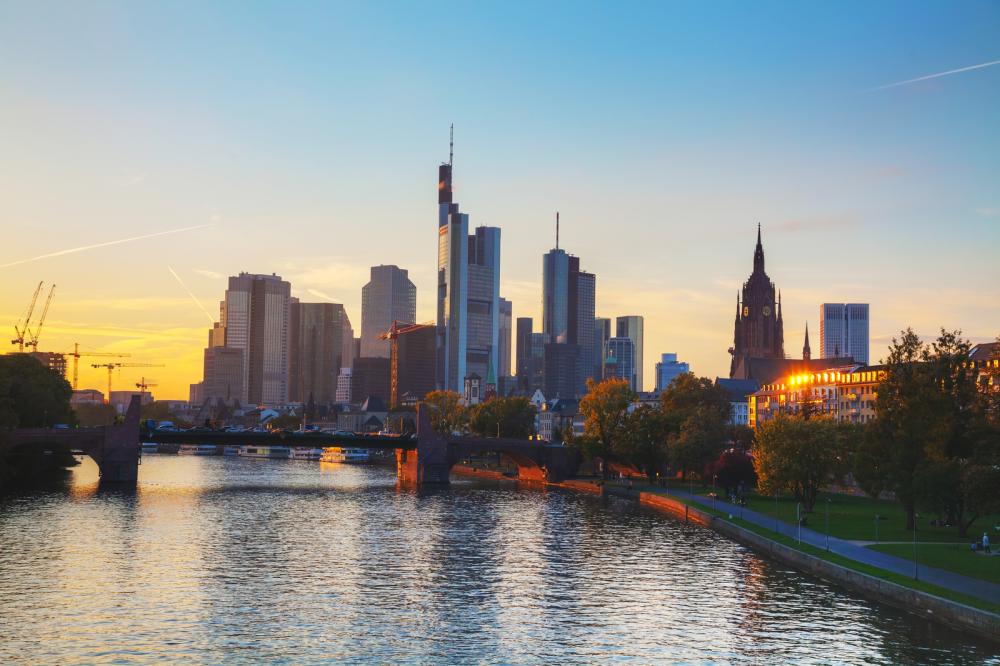 The German Travel Memories expand on our GamesforLanguage travel-story based courses, which use the cities' real street names, places, restaurants, hotels, etc. We visited many of them ourselves and tell you a little more about each German city.
The German Travel Memories expand on our GamesforLanguage travel-story based courses, which use the cities' real street names, places, restaurants, hotels, etc. We visited many of them ourselves and tell you a little more about each German city.
In future blog posts, we'll provide additional details for each of the cities our young travelers visit in Germany, France, Italy, and Spain.
That we chose Frankfurt for Michael's first stop in Germany was no accident: My husband Peter grew up in Bad Nauheim, a small town 20 miles north of Frankfurt. (Skyline of Frankfurt across the Main River at sunset)
Ken Burns' PBS documentary reminded us recently that Franklin Roosevelt had attended school in Bad Nauheim for several weeks, while his father sought the water cure for his heart condition. (Read our post: Where “Bad” doesn't mean “bad” - Franklin Roosevelt in Germany...)
Visiting Frankfurt? Here's a short introduction to this lively, cosmopolitan German city. We'll also list a few basic terms in German that will help you make your own travel memories.
We'll follow Michael's discoveries in Frankfurt, for those of you who have done or are doing our German 1 course: Michael in Deutschland.
In our travel-story course, you learn daily conversational language. The vocabulary listed here is a combination of some words taught in the course as well as other useful terms.
Quick Facts about Frankfurt
Frankfurt am Main is located on an ancient ford (German: "Furt") on the Main River in the federal state of Hesse.
(There's also a Frankfurt an der Oder, a city that is located on the Oder River in the state of Brandenburg, at the Polish border.)
Frankfurt am Main is the 5th largest city in Germany. Its metropolitan area has a population of over 5 million. The city is an important financial center. Its stock exchange (Frankfurter Wertpapierbörse, FWB) ranks among the top 10 stock exchanges of the world. (Frankfurt with the twin towers of the "Deutsche Bank" below)
Frankfurt is also known for its trade fairs, which go back in history to the Middle Ages. The city hosts the world's largest book fair, which takes place annually in October. The first Frankfurt Book Fair was held in 1485. (For further reading)
- der Fluss - the river
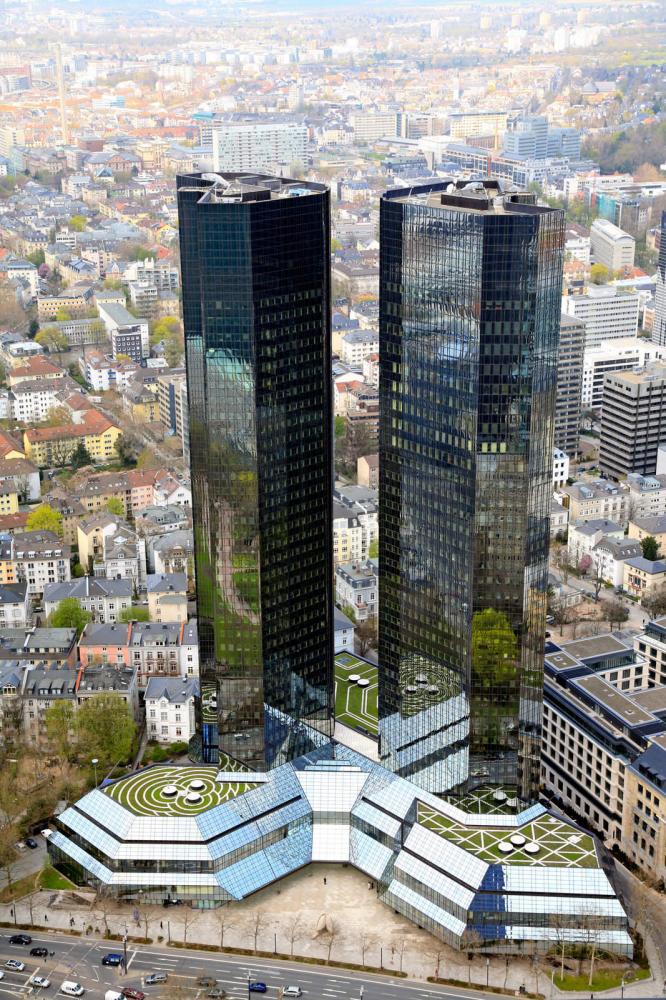
- das Bundesland - the federal state
- die Grenze - the border
- die Stadt - the city
- der Großraum - the metropolitan area
- die Bevölkerung - the population
- das Finanzzentrum - the financial center
- die Börse - the stock exchange
- die Buchmesse - the book fair
Frankfurt Airport
Michael is a young student who learned some German at home and later studied it in school. However, this will be his first visit to Germany.
On his flight to Frankfurt, Michael chats in German with the flight attendant and with the woman who sits next to him.
Frankfurt airport is the 4th busiest airport in Europe, after London, Paris, and Istanbul. With its 297 destinations in 104 countries (as of 2015), Frankfurt's airport may have the most international destinations in the world. (Further information)
As Michael goes through passport control, he continues to use his German. Responding to the standard immigration/passport control questions, he has to explain why he is traveling to Germany and how long he will stay.
- der Flug - the flight
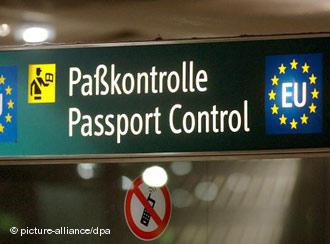
- der/die Flugbegleiter(in) - the flight attendant m/f
- der Flughafen - the airport
die Passkontrolle - the Passport Control (did you notice the "Paßkontrolle" spelling on the picture? If you don't know, which one is correct or why, write as at contact, or comment below and we'll explain.)
- Sind Sie geschäftlich hier? - Are you here on business?
- Wie lange bleiben Sie? - How long are you staying?
- Eine gute Zeit! - Have a good time!
(A few years ago, we made our own travel memories, trying out the dialog of Scene 4, and the officer responded exactly as in our dialog - "Guten Morgen. Sie sprechen Deutsch!" - when I gave him my American passport but greeted him in German.)
Districts of Frankfurt
Frankfurt is divided into 46 districts. The financial center spreads across several districts in and near the inner city.
A little farther out, you'll find a number of residential areas that are still well-connected by subway and tram to the city center and its core, the historical quarter.
Leipziger Straße, where Michael's aunt and uncle live, is a charming street with bistros, shops, and apartments in the residential district called Bockenheim.
Not far from Leipziger Straße is one of the four campuses of the Johann Wolfgang Goethe-Universität with its lively student quarter.
(Aerial view of Frankfurt-Bockenheim below, right)
- der Stadtteil - the (city) district
- die Innenstadt - the inner city
- die Wohngegend - the residential area
- die U-Bahn - the subway
- das Universitätsgelände (der Campus) - the campus
- das Studentenviertel - the student quarter
- die Kneipe - the pub
- das Geschäft - the shop
Der Römerberg
Michael's cousin Julia shows him around Frankfurt's historic quarter ("Altstadt").
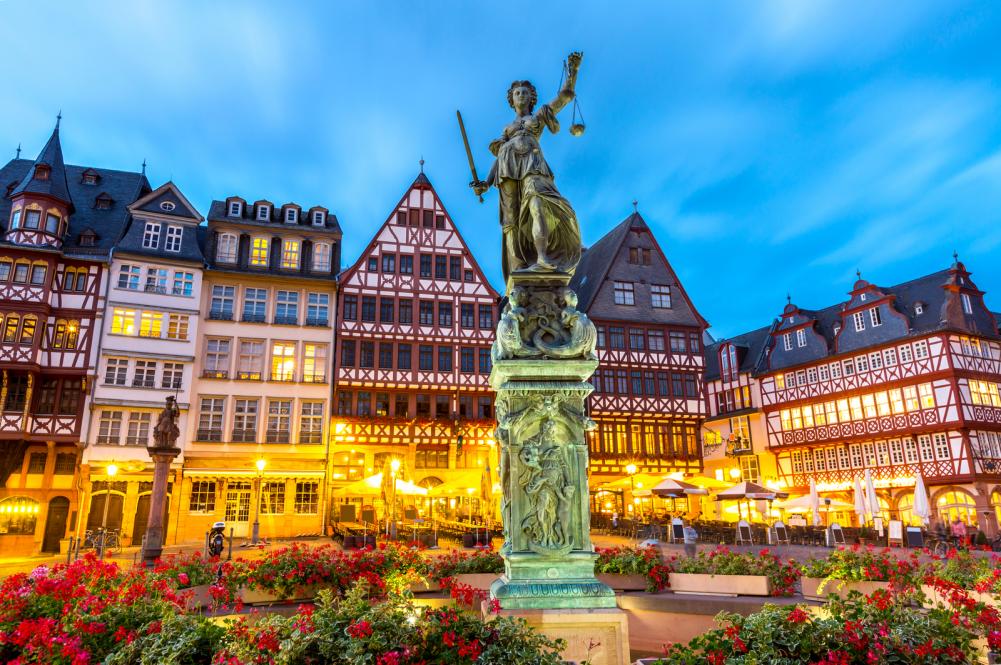 They walk across the central market square, which is called "Römerberg," (see picture left with Justizia statue) literally translated as "Roman mountain." Curiously enough, the name may have nothing to do with early Roman settlement, which can be documented for the time between 75 and 260 A.D. (or if you prefer, C.E.)
They walk across the central market square, which is called "Römerberg," (see picture left with Justizia statue) literally translated as "Roman mountain." Curiously enough, the name may have nothing to do with early Roman settlement, which can be documented for the time between 75 and 260 A.D. (or if you prefer, C.E.)
Rather, there are various speculations about the origin of the name "Römerberg." One idea is that the name comes from the presence of Italian merchants that frequented the popular meeting place for fairs and markets during the Middle Ages.
Another is that the square was considered a focal point for celebrations during the Holy Roman Empire (a multi-ethnic empire, which lasted from the early Middle Ages to the early 19th century and included, among others, the Kingdoms of Germany, Bavaria, Burgundy, and Italy.) For more information click here.
Frankfurt was heavily bombed during World War II (1939-1945) and its historic city center was reduced to rubble. Most of Frankfurt was rapidly built up again, but without much attention paid to architectural style.
However, city planning took hold in the 60s and 70s and in the 1980s, some of the buildings in the historic city center were rebuilt in the old style. In 2010/11 a new effort was started, called the "Dom-Römer Projekt," to reconstruct another 35 buildings using old historical plans.
Reconstruction has included the timber-framed houses on the Römerberg, as well as the city hall, called "der Römer." The step-gabled house became Frankfurt's city hall in the 15th century and has been the seat of city government ever since.
(See picture below right of Frankfurt old town.)
- der Berg - the mountain
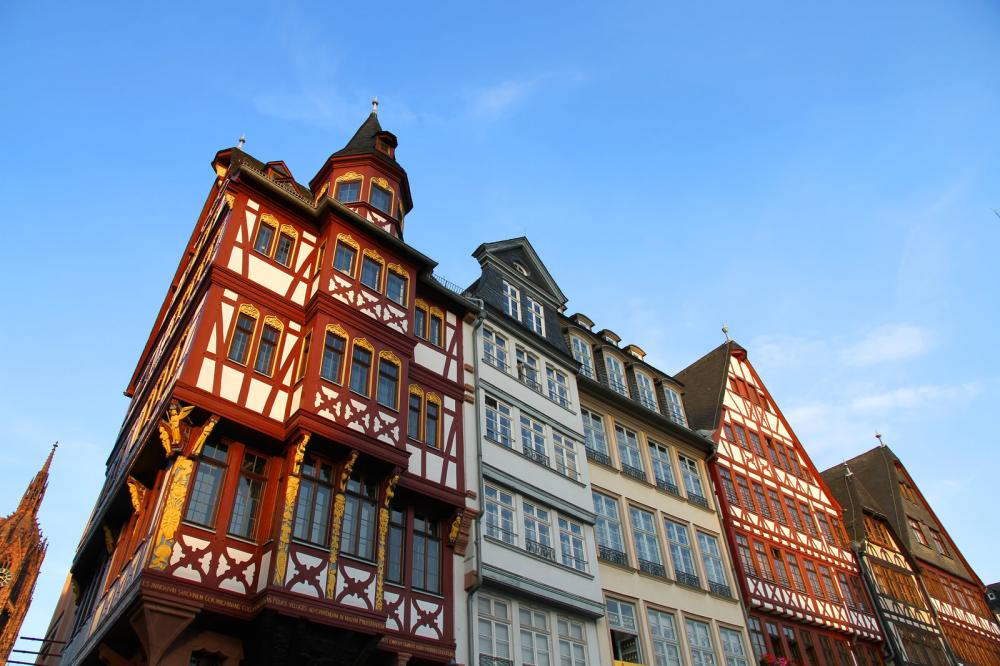
- die Römer - the Romans
- der Römer - Frankfurt's city hall
- das Rathaus - the city hall
- das Mittelalter - the Middle Ages
- die Altstadt - the history quarter
- der Marktplatz - the market place
- das Gebäude - the building
- das Fachwerkhaus - the timber-framed house
- der Weltkrieg - the world war
If you happen to visit Frankfurt, here is a suggestion for a walk through the Old Town.
Die Zeil
During their walk through the historic center, his cousin Julia asks Michael if he wants to go to the Zeil with her to do some shopping. It's about a 10 minute walk from the Römerberg to get there.
Die Zeil is a well-known, busy shopping street in the center (Innenstadt) of Frankfurt. Its name dates back to the 14th century, when it referred to a specific row of houses. Over the centuries, the street was extented and became a boulevard of palaces, grand buildings in various architectural styles, fine restaurants, and numerous department stores. Many of these were not rebuilt after the second World War.
From 2004 to 2009, the Zeil underwent major renovations, and the Myzeil shopping arcade with its gigantic glass façade was added. It has eight floors and its architecture is stunning.
(See picture of MyZeil shopping arcade below, right)
- die Zeile - the row
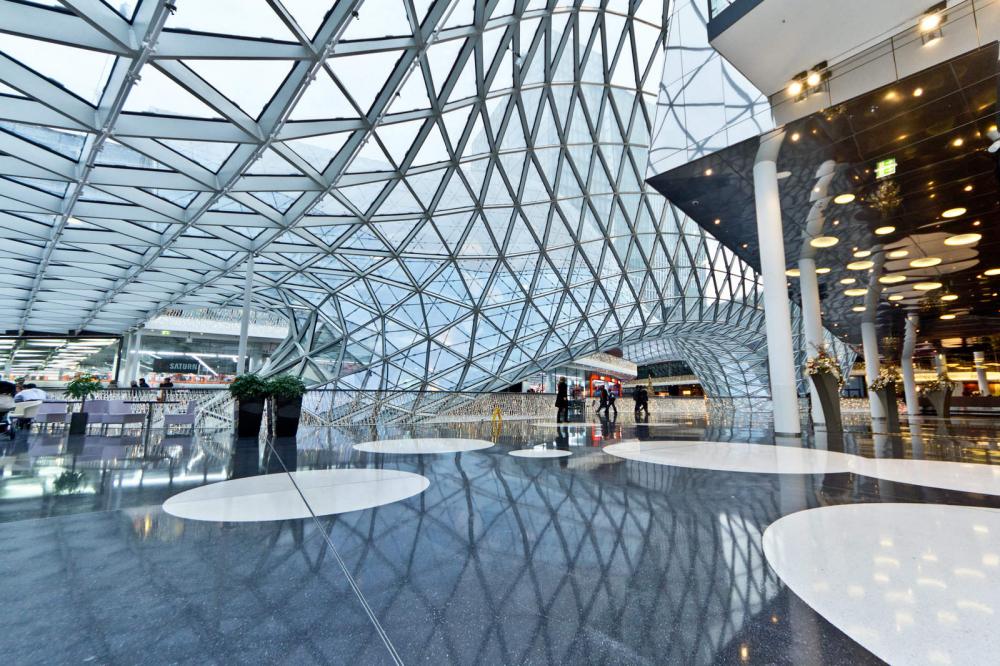
- die Einkaufsstraße - the shopping street
- der Reiseführer - the travel guide
- die Renovierung - the renovation
- das Kaufhaus - the department store
- die Architektur - the architecture
Das Frankfurter Goethe-Haus
Johann Wolfgang von Goethe (1749-1832), Germany's most famous writer, was born and grew up in Frankfurt am Main, then still an Imperial Free City of the Holy Roman Empire.
Goethe got his education from private tutors, with a special focus on languages (Latin, Greek, French, Italian, English, and Hebrew). He loved drawing, and read as much as he could of literature, history, and religion, in books that were in his father's library.
In 1765, at the age of 16, he (reluctantly) began his law studies, at the universities of Leipzig and Straßburg, finishing his law degree in Frankfurt in 1771. During his time as a student, he became close friends with other writers, fell in and out of love, and started writing passionate poetry himself. In 1772, he gave up his law career and left Frankfurt. (
Goethe is probably best known for two works. One is his loosely autobiographical Sturm and Drang novel "The Sorrows of Young Werther" (1774), which he wrote in the course of six weeks. Upon publication, the novel instantly made him world famous. People started dressing and acting like the young Werther. Unfortunately, it also led to some copycat suicides.
Goethe's Italian travel memories ("Italienische Reise") were subject of a New York Times article.
Goethe's other well-known work is the drama "Faust I" (published in 1806). This was a reworking of the old Faust legend - a scholar's pact with the devil - that had been popularized by Marlowe in his "Tragical History of Doctor Faustus" (1604).
The Goethe-Haus (see picture below, right) documents the writer's formative years in Frankfurt. (For further reading about Goethe, click on this Wiki entry)
- der Dichter - the poet, writer
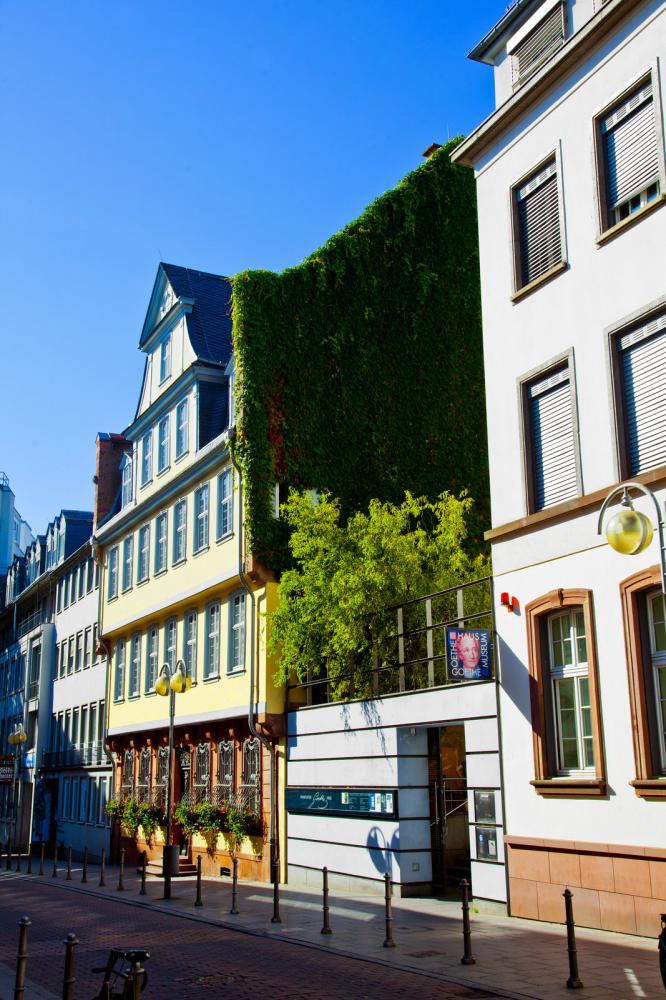
- die Kaiserstadt - the Imperial City
- die Bildung/Ausbildung - the education
- die Sprache - the language
- die Bibliothek - the library
- das Jurastudium - the law studies
- das Gedicht - the poem
- Sturm und Drang - Storm and Stress (early Romanticism)
- Die Leiden des jungen Werther - The Sorrows of Young Werther
Michael spends a few more days in Frankfurt. Among the other sites he visits, these may also interest you:
Other Places to visit in Frankfurt
The Archäologische Garten: an archeological museum that includes remnants of ancient Roman settlement.
Frankfurt Cathedral: the city's main cathedral, constructed in the 14th and 15th centuries. Roman-German emperors were crowned here during the time of the Holy Roman Empire.
Haus Wertheim: a timber-framed house on the Römerberg that was undamaged during World War II.
The Alte Oper: the former opera house, built in 1880.
Michael's Next Travel Memories Stop
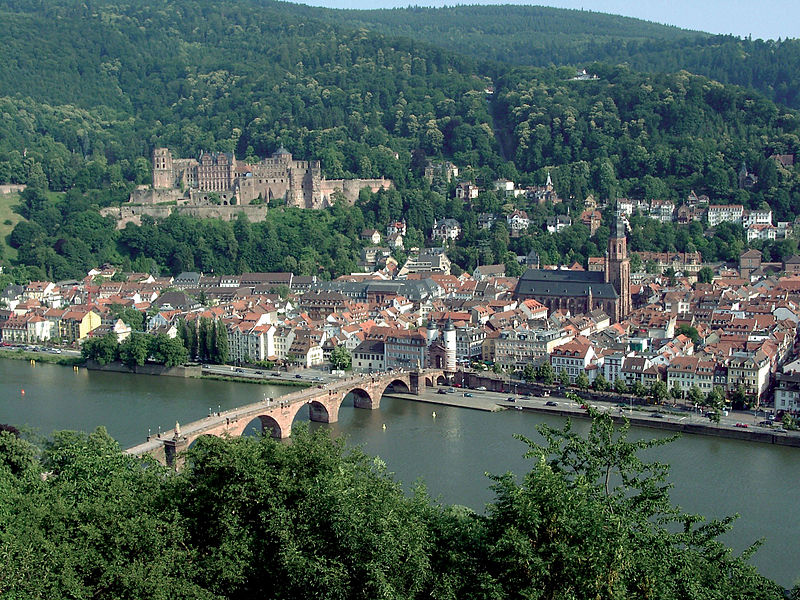 From Frankfurt, Michael takes the train to Heidelberg. There he gets together with a friend he had met in Boston. Read about Heidelberg in German Travel Memories 2 - Michael in Heidelberg.
From Frankfurt, Michael takes the train to Heidelberg. There he gets together with a friend he had met in Boston. Read about Heidelberg in German Travel Memories 2 - Michael in Heidelberg.
Register or log in again and continue with the German 1 course. When you reach the Heidelberg Scene you'll also learn the English translation of the town's name.
In Why did Mark Twain like Heidelberg? we further speculate about why Twain stayed in Heidelberg for three months in 1878.
Bio: Ulrike Rettig is the co-founder of GamesforLanguage.com. She is a lifelong language learner, growing up in Austria, the Netherlands, and Canada. You can follow her on Facebook, Twitter and Instagram, and leave any comments with contact.
